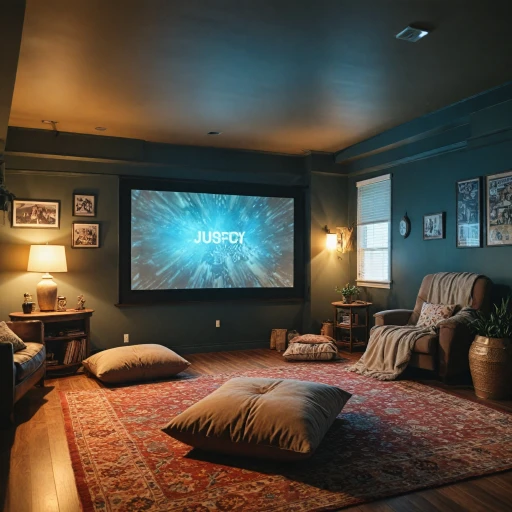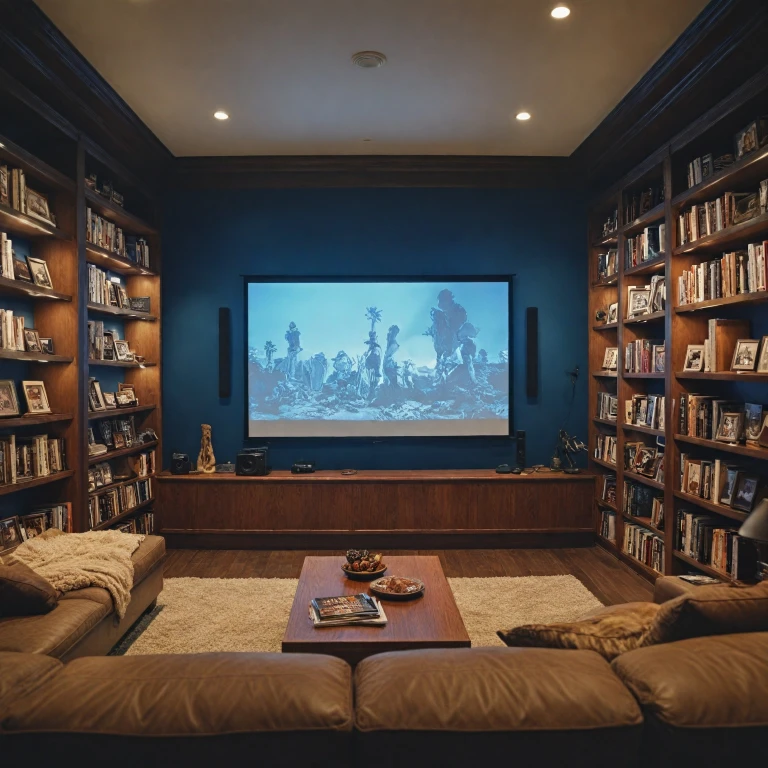Understanding Screen Size and Viewing Distance
Optimal Viewing Distance for a Perfect Experience
When choosing the right 150-inch projector screen, one crucial aspect to consider is the optimal viewing distance. A larger screen, like a 150-inch model, demands careful planning to ensure your home theater delivers a compelling visual experience.
Often, the recommended viewing distance is 1.5 to 2.5 times the diagonal size of the screen. So, for a 150-inch screen, this translates to a distance of roughly 18 to 31 feet. This range provides an ideal balance where images remain sharp, and the field of vision is adequately covered.
However, it can also depend on the type of projector you have; ultra short throw projectors or short throw projectors can alter these standard measurements by allowing closer positioning without sacrificing image quality.
Don't Forget Ambient Light Factors
Ambient light is another critical factor in screen choice and placement. Even the best projection screens need the right environment to perform well. For well-lit rooms, screens with ambient light rejecting technology can provide a more vivid picture. Light rejecting capabilities come into play with screen color and material. A matte white screen can offer neutrality, but elite screens or those with higher gain typically counteract ambient light better.
Seamless Integration
To create an engaging home theater experience, the screen should be a seamless addition to your space. For instance, if your room allows, a fixed frame screen provides a sturdy option and typically offers an edge-free viewing. Those preferring versatility might lean towards electric motorized screens or even tab tension models that provide a smooth, tensioned surface for projection.
Crafting your ultimate cinema experience involves choices beyond mere screen size. From selecting material and style to considering budget constraints and maintenance requirements, each of these decisions will shape your theater setup. If you’re ready to experience cinematic magic, explore even larger screens capable of delivering an unforgettable journey
here. Consider every aspect to make an informed decision.
Material Matters: Selecting the Right Screen Fabric
Choosing the Perfect Screen Material
Selecting the right screen material is crucial for an optimal viewing experience in your home theater. The material you choose can significantly impact the image quality projected, so it's essential to consider several factors before making a decision.
One of the primary considerations is the gain of the screen. Gain is a measure of how much light the screen reflects back toward the audience. A higher gain can make images appear brighter, beneficial in environments with some ambient light. Matte white screens are a popular choice for their color neutrality and wide viewing angles. They ensure consistent picture quality across all viewing positions, regardless of changes in ambient light conditions.
For those dealing with challenging lighting, a light rejecting screen can be advantageous. These screens are engineered to reject ambient light, maintaining sharper and more colorful images. Fixed frame options, such as those from elite screens, are excellent choices for dedicated theater rooms due to their edge-free design. On the other hand, if versatility is a key requirement, electric or electric motorized screens offer flexibility by retracting when not in use.
Projection screens today cater to a range of projectors, including ultra short throw projectors that require specialized material to prevent image distortion at close distances.
Frame and mounting style should also be taken into account. Fixed frame projector screens can provide a perfectly tensioned screen surface, but they need adequate wall space.
By understanding your needs and the available options, you can enhance your viewing experience. For more insights on choosing the appropriate materials, check out this guide on
sound permeable screens.
Aspect Ratio Considerations
Keep the Ratio in Check for a Stunning Visual Experience
When it comes to choosing a 150-inch projector screen for your home theater, understanding aspect ratio is pivotal to achieving a seamless visual experience. A screen’s aspect ratio refers to the proportional relationship between its width and height, and this plays a crucial role in how images from your projector will display.
For the most commonly used aspect ratios, here are some considerations:
- 16:9 – Widescreen Aspect Ratio: This is a popular choice for home theaters as it aligns with most modern projectors and TV formats. Ideal for watching movies, sports, and shows, the 16:9 aspect ratio offers full-screen viewing without large black bars, especially if you have a fixed frame screen or an elite motorized option.
- 4:3 – Classic Television and Presentation Format: Less common for cinema-like experiences, the classic 4:3 ratio is primarily beneficial for educational or business presentations. Bear in mind, compatibility with current projector models can be limited.
- 2.35:1 – CinemaScope Ratio: If you’re a cinephile seeking a true theater-touch, the ultra-wide 2.35:1 ratio makes for spectacular full-frame movie watching. Fixed frame projector screens in this ratio can minimize light reflections and optimize image quality under ambient light conditions.
The type of content you consume most often will guide you in selecting the right aspect ratio. Remember, adjusting your choice of projector or projection screen can significantly impact viewing experiences, especially in regular or ultra short throw settings.
When thinking about mounting and installation options for your projector and screen, note the importance of accommodating your preferred aspect ratio to avoid distorted or clipped images. If you're interested in exploring unique mounting setups that complement your screen setup, consider reading more about
enhancing your home theater with mounting solutions.
Mounting and Installation Options
Installation Options and Considerations
When setting up your home theater with a 150-inch projector screen, the installation process is crucial to delivering an exceptional visual experience. Let's explore the various options and what to keep in mind during installation.
Deciding between a fixed frame and an electric motorized screen is one of the first choices you'll encounter. Fixed frame projector screens offer a constant tension, providing a perfectly flat surface for projection. These screens are typically adorned with a sleek black border to enhance contrast yet are less adaptable since they're a permanent fixture.
In contrast, an electric motorized screen adds versatility, allowing you to roll up the screen when not in use. This option is fantastic for multi-purpose rooms where screen space may be required for other activities. However, they generally command a higher price compared to their fixed counterparts.
Space and Placement
Consider the available space in your theater room and the projection throw distance. Ultra short throw projectors are ideal if your room is spatially constrained, minimizing the gap needed between the projector and the screen.
Viewing Experience Enhancements
Ambient light rejection technology can be a game-changer if your theater room isn't completely dark. Screens with this capability, often available in matte white or white finishes, ensure the images projected remain vibrant, contrasting regular projector screens' susceptibility to wash out under extra light.
Elite Screens offer a series of durable "edge-free" models, allowing the image to extend to the very edges of the screen, augmenting the immersive effect. Notably, edge-free screens purchased at sale prices can offer significant savings compared to their regular price.
Mounting Techniques
Whether you're considering a tab tension projection screen for added smoothness or a more traditional mounting, ensure the frame's integrity to prevent long-term sagging. A solid mounting ensures the projection surface remains taut, preserving the image quality.
Ultimately, the choice between a fixed frame or electric motorized system, coupled with your specific room requirements, will dictate the ideal setup for your home theater. Proper installation not only influences the aesthetics but also impacts the longevity and functionality of your new 150-inch projector screen.
Budgeting for a 150-Inch Projector Screen
Balancing Your Budget with Quality Needs
When considering a 150-inch projector screen for your home theater, balancing quality and cost is essential. While it might be tempting to opt for the lowest price available, it's worth noting that the regular price often reflects the screen's material, build quality, and extra features such as light rejecting capabilities or ultra short throw compatibility.
- Fixed Frame vs. Electric Motorized: Fixed frame projector screens tend to offer a more stable and consistent surface for projections, which can be ideal for regular home viewing. On the other hand, an electric motorized screen provides added convenience, as it can retract into a sleek frame at the touch of a button. This feature may be more costly but could enhance daily use.
- Material and Gain: Screens with a matte white finish offer neutral light reflection and suit most viewing environments, while 'high gain' screens are better suited to rooms with ambient light interference. The price can vary significantly based on these materials, with elite screens offering some of the highest quality fixed frame and electric motorized options.
- Aspect Ratio and Series: The cost may differ based on the screen's aspect ratio and whether it belongs to a premium series like elite screens' Edge Free series. While standard 16:9 screens are common, those catering to more specialized projectors might come at a premium.
- Sale Opportunities: Keep an eye out for sales that can bring premium screens within budget. Whether looking for a fixed frame or an electric model with tab tension to keep a smooth surface, sale price reductions can make these options more attainable.
For those aiming to achieve a top-tier theater-like experience at home, understanding the relationship between price and feature set is crucial. It's advisable to assess your specific needs, taking into consideration things like ultra short throw projectors and ambient light conditions, as these will direct you to the most suitable screen choices within your financial limits.
Maintenance and Longevity
Ensuring Your Screen's Durability
When investing in a 150-inch projector screen, considering its longevity is crucial. The material you choose plays a significant role. Options like matte white and light rejecting fabrics not only enhance image quality but also resist wear and tear over time. Regular cleaning using recommended solutions can prolong your screen's life.
Preventative Care for Optimal Performance
The installation type—whether it's a fixed frame or electric motorized—also affects maintenance frequency. Screens mounted in controlled environments, such as those using ultra short throw projectors, often require less attention. For electric motorized screens, ensuring mechanisms are free from dust and debris can prevent operational issues.
Budgeting for Maintenance
In addition to the regular price or sale price of a screen, allocate a budget for necessary upkeep. Protective measures, like screen covers when not in use, can reduce the need for repairs. Explore options like elite screens with features designed for longevity, offering a good balance between cost and durability.
These steps ensure your screen remains an integral part of your home theater projection setup for years to come.

